Carlton South Public School: Community Engagement Report and Analysis
VerifiedAdded on 2023/06/03
|8
|2280
|252
Report
AI Summary
This report details a student's volunteering experience at Carlton South Public School, focusing on after-school care for children aged 5-10. The report outlines the volunteer's responsibilities, including interacting with children, managing activities, and ensuring a positive environment. It identifies challenges related to timing, safety, and curriculum, while emphasizing the importance of ethical and social responsibility. The report aligns the volunteer's practices with community engagement theory, highlighting the role of parental involvement and community collaboration in enhancing student learning and well-being. Recommendations are provided to improve community engagement through expanded volunteer opportunities, curriculum integration, and enhanced communication between volunteers, parents, and the school. The report also reflects on the development of personal and professional skills through volunteering, such as patience, tolerance, and facilitation skills.
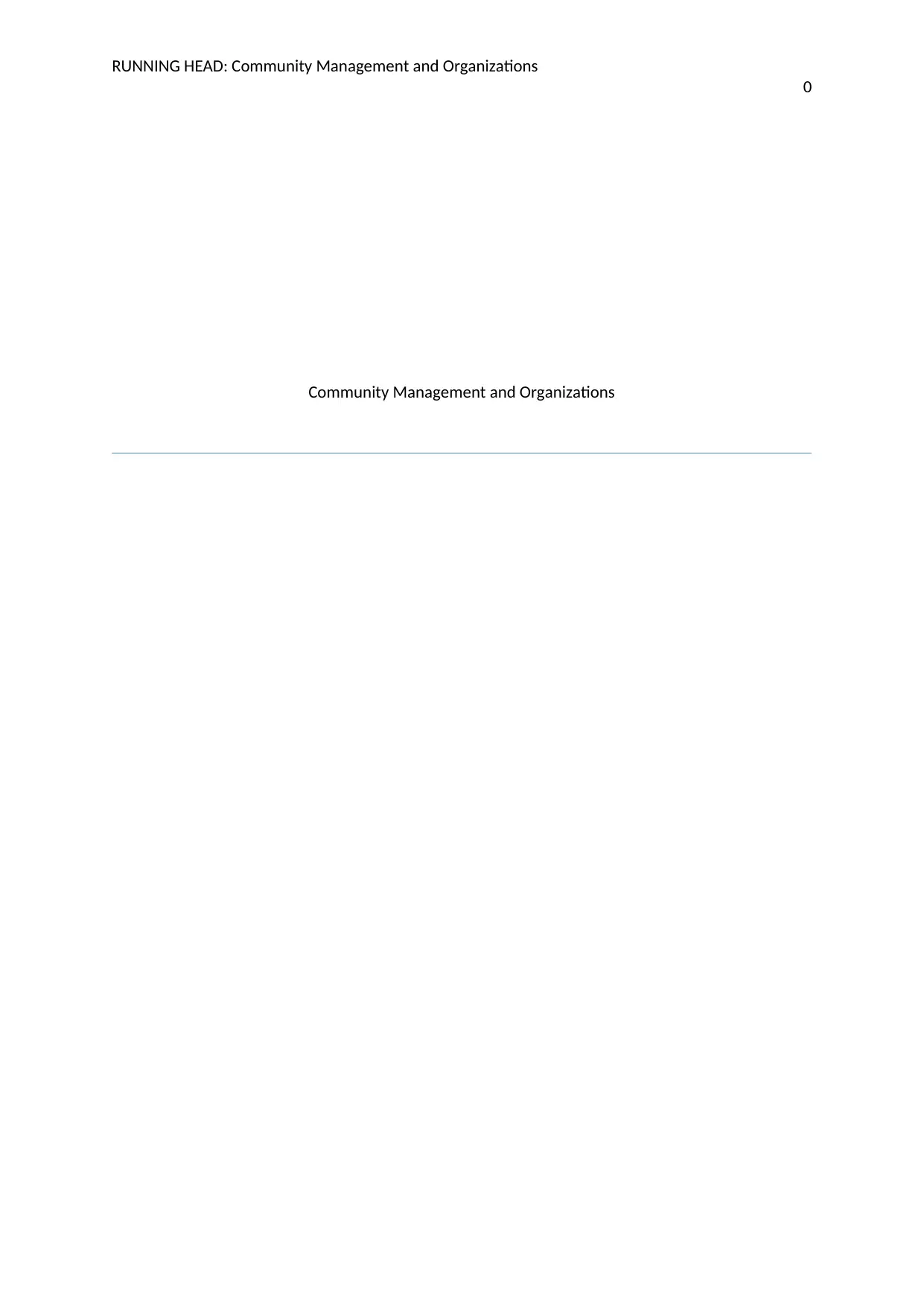
RUNNING HEAD: Community Management and Organizations
0
Community Management and Organizations
0
Community Management and Organizations
Paraphrase This Document
Need a fresh take? Get an instant paraphrase of this document with our AI Paraphraser
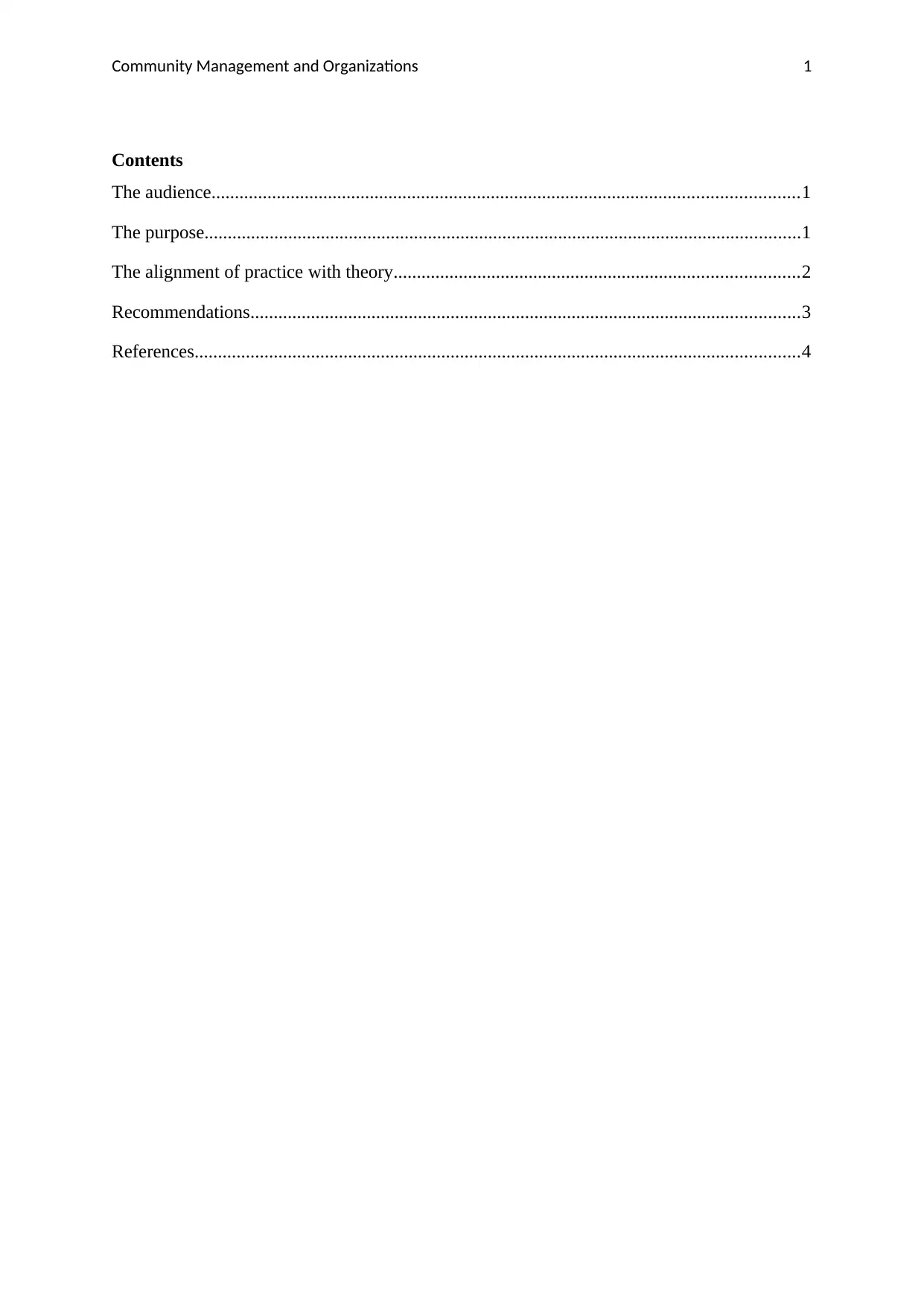
Community Management and Organizations 1
Contents
The audience..............................................................................................................................1
The purpose................................................................................................................................1
The alignment of practice with theory.......................................................................................2
Recommendations......................................................................................................................3
References..................................................................................................................................4
Contents
The audience..............................................................................................................................1
The purpose................................................................................................................................1
The alignment of practice with theory.......................................................................................2
Recommendations......................................................................................................................3
References..................................................................................................................................4
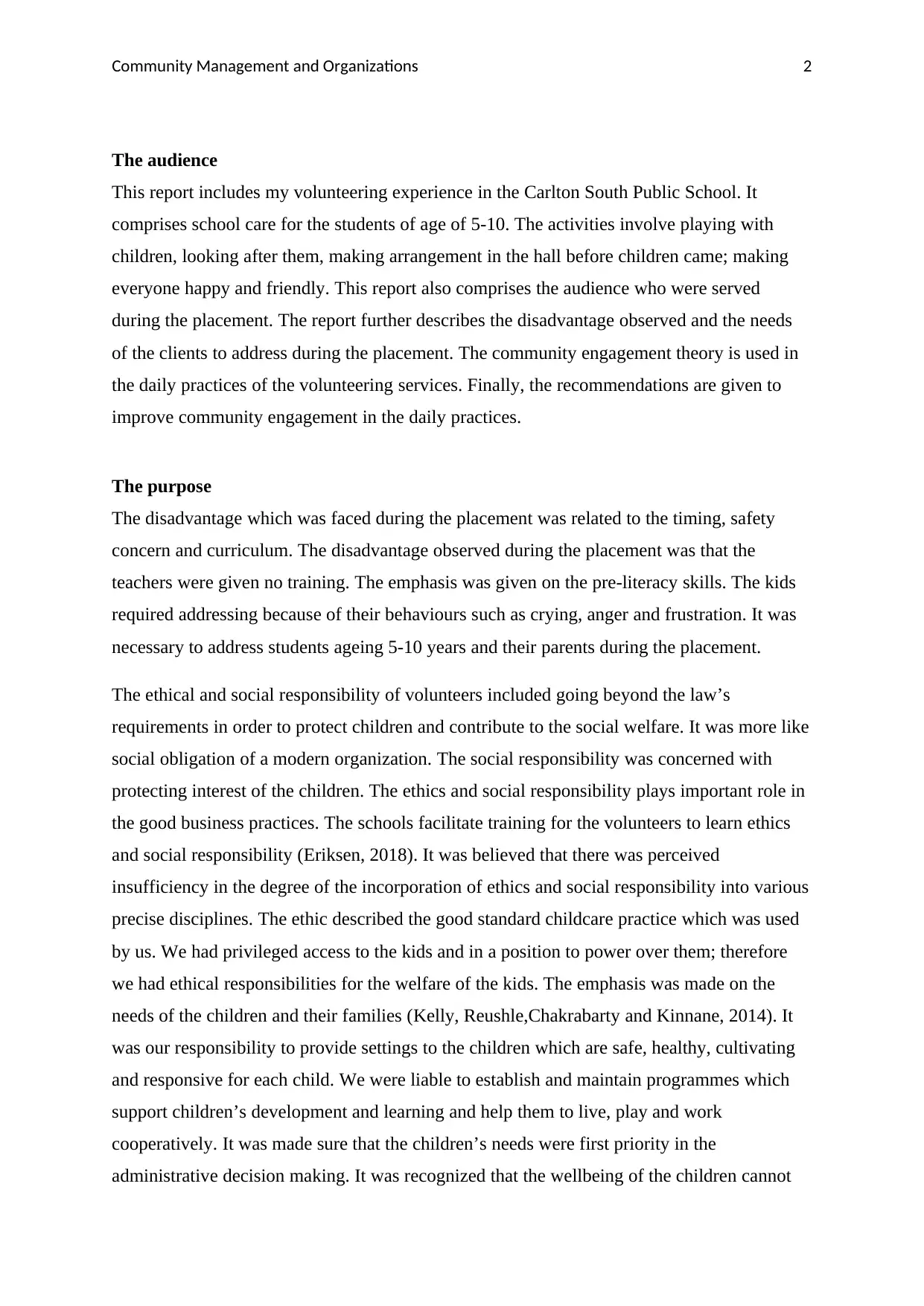
Community Management and Organizations 2
The audience
This report includes my volunteering experience in the Carlton South Public School. It
comprises school care for the students of age of 5-10. The activities involve playing with
children, looking after them, making arrangement in the hall before children came; making
everyone happy and friendly. This report also comprises the audience who were served
during the placement. The report further describes the disadvantage observed and the needs
of the clients to address during the placement. The community engagement theory is used in
the daily practices of the volunteering services. Finally, the recommendations are given to
improve community engagement in the daily practices.
The purpose
The disadvantage which was faced during the placement was related to the timing, safety
concern and curriculum. The disadvantage observed during the placement was that the
teachers were given no training. The emphasis was given on the pre-literacy skills. The kids
required addressing because of their behaviours such as crying, anger and frustration. It was
necessary to address students ageing 5-10 years and their parents during the placement.
The ethical and social responsibility of volunteers included going beyond the law’s
requirements in order to protect children and contribute to the social welfare. It was more like
social obligation of a modern organization. The social responsibility was concerned with
protecting interest of the children. The ethics and social responsibility plays important role in
the good business practices. The schools facilitate training for the volunteers to learn ethics
and social responsibility (Eriksen, 2018). It was believed that there was perceived
insufficiency in the degree of the incorporation of ethics and social responsibility into various
precise disciplines. The ethic described the good standard childcare practice which was used
by us. We had privileged access to the kids and in a position to power over them; therefore
we had ethical responsibilities for the welfare of the kids. The emphasis was made on the
needs of the children and their families (Kelly, Reushle,Chakrabarty and Kinnane, 2014). It
was our responsibility to provide settings to the children which are safe, healthy, cultivating
and responsive for each child. We were liable to establish and maintain programmes which
support children’s development and learning and help them to live, play and work
cooperatively. It was made sure that the children’s needs were first priority in the
administrative decision making. It was recognized that the wellbeing of the children cannot
The audience
This report includes my volunteering experience in the Carlton South Public School. It
comprises school care for the students of age of 5-10. The activities involve playing with
children, looking after them, making arrangement in the hall before children came; making
everyone happy and friendly. This report also comprises the audience who were served
during the placement. The report further describes the disadvantage observed and the needs
of the clients to address during the placement. The community engagement theory is used in
the daily practices of the volunteering services. Finally, the recommendations are given to
improve community engagement in the daily practices.
The purpose
The disadvantage which was faced during the placement was related to the timing, safety
concern and curriculum. The disadvantage observed during the placement was that the
teachers were given no training. The emphasis was given on the pre-literacy skills. The kids
required addressing because of their behaviours such as crying, anger and frustration. It was
necessary to address students ageing 5-10 years and their parents during the placement.
The ethical and social responsibility of volunteers included going beyond the law’s
requirements in order to protect children and contribute to the social welfare. It was more like
social obligation of a modern organization. The social responsibility was concerned with
protecting interest of the children. The ethics and social responsibility plays important role in
the good business practices. The schools facilitate training for the volunteers to learn ethics
and social responsibility (Eriksen, 2018). It was believed that there was perceived
insufficiency in the degree of the incorporation of ethics and social responsibility into various
precise disciplines. The ethic described the good standard childcare practice which was used
by us. We had privileged access to the kids and in a position to power over them; therefore
we had ethical responsibilities for the welfare of the kids. The emphasis was made on the
needs of the children and their families (Kelly, Reushle,Chakrabarty and Kinnane, 2014). It
was our responsibility to provide settings to the children which are safe, healthy, cultivating
and responsive for each child. We were liable to establish and maintain programmes which
support children’s development and learning and help them to live, play and work
cooperatively. It was made sure that the children’s needs were first priority in the
administrative decision making. It was recognized that the wellbeing of the children cannot
⊘ This is a preview!⊘
Do you want full access?
Subscribe today to unlock all pages.

Trusted by 1+ million students worldwide
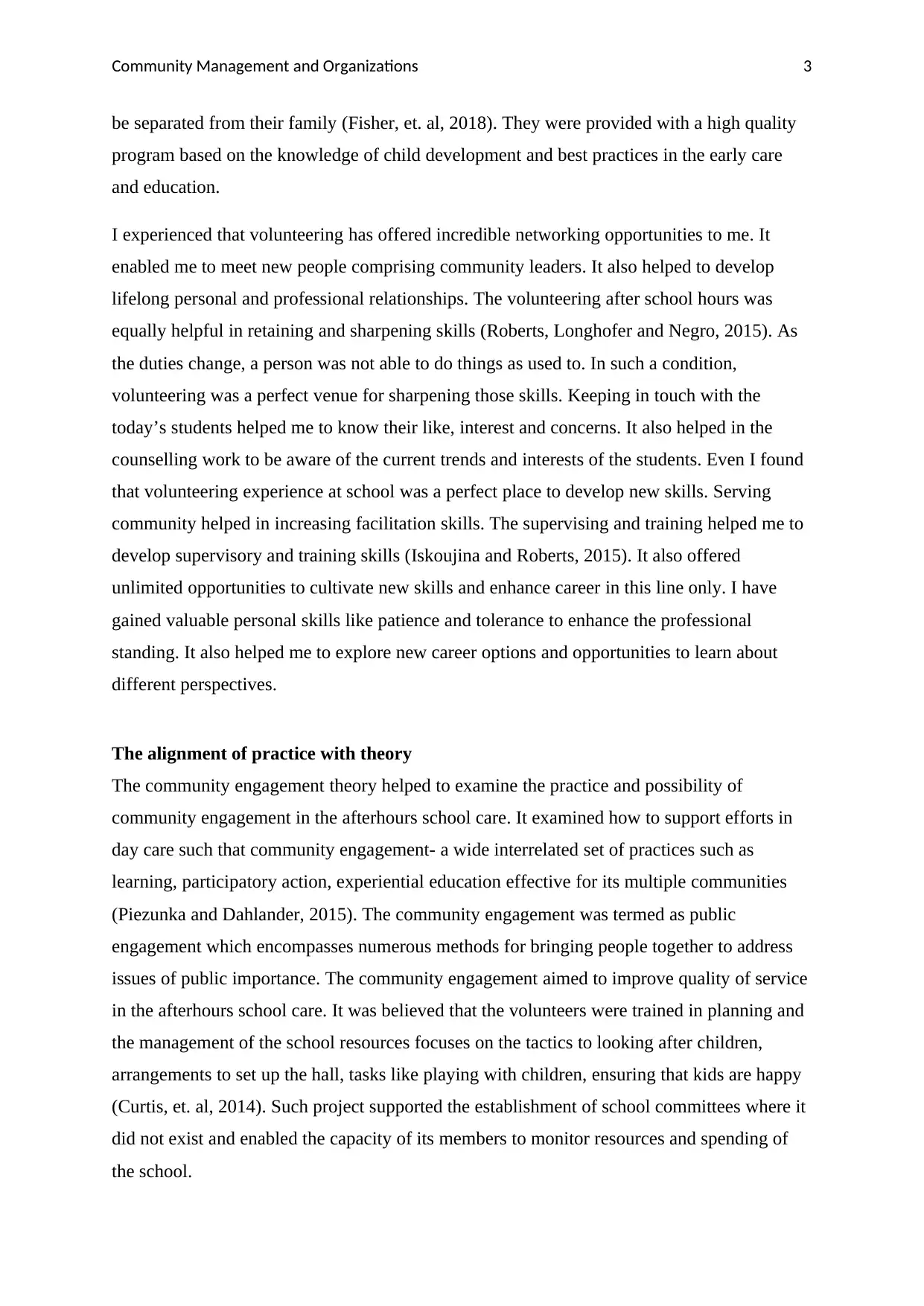
Community Management and Organizations 3
be separated from their family (Fisher, et. al, 2018). They were provided with a high quality
program based on the knowledge of child development and best practices in the early care
and education.
I experienced that volunteering has offered incredible networking opportunities to me. It
enabled me to meet new people comprising community leaders. It also helped to develop
lifelong personal and professional relationships. The volunteering after school hours was
equally helpful in retaining and sharpening skills (Roberts, Longhofer and Negro, 2015). As
the duties change, a person was not able to do things as used to. In such a condition,
volunteering was a perfect venue for sharpening those skills. Keeping in touch with the
today’s students helped me to know their like, interest and concerns. It also helped in the
counselling work to be aware of the current trends and interests of the students. Even I found
that volunteering experience at school was a perfect place to develop new skills. Serving
community helped in increasing facilitation skills. The supervising and training helped me to
develop supervisory and training skills (Iskoujina and Roberts, 2015). It also offered
unlimited opportunities to cultivate new skills and enhance career in this line only. I have
gained valuable personal skills like patience and tolerance to enhance the professional
standing. It also helped me to explore new career options and opportunities to learn about
different perspectives.
The alignment of practice with theory
The community engagement theory helped to examine the practice and possibility of
community engagement in the afterhours school care. It examined how to support efforts in
day care such that community engagement- a wide interrelated set of practices such as
learning, participatory action, experiential education effective for its multiple communities
(Piezunka and Dahlander, 2015). The community engagement was termed as public
engagement which encompasses numerous methods for bringing people together to address
issues of public importance. The community engagement aimed to improve quality of service
in the afterhours school care. It was believed that the volunteers were trained in planning and
the management of the school resources focuses on the tactics to looking after children,
arrangements to set up the hall, tasks like playing with children, ensuring that kids are happy
(Curtis, et. al, 2014). Such project supported the establishment of school committees where it
did not exist and enabled the capacity of its members to monitor resources and spending of
the school.
be separated from their family (Fisher, et. al, 2018). They were provided with a high quality
program based on the knowledge of child development and best practices in the early care
and education.
I experienced that volunteering has offered incredible networking opportunities to me. It
enabled me to meet new people comprising community leaders. It also helped to develop
lifelong personal and professional relationships. The volunteering after school hours was
equally helpful in retaining and sharpening skills (Roberts, Longhofer and Negro, 2015). As
the duties change, a person was not able to do things as used to. In such a condition,
volunteering was a perfect venue for sharpening those skills. Keeping in touch with the
today’s students helped me to know their like, interest and concerns. It also helped in the
counselling work to be aware of the current trends and interests of the students. Even I found
that volunteering experience at school was a perfect place to develop new skills. Serving
community helped in increasing facilitation skills. The supervising and training helped me to
develop supervisory and training skills (Iskoujina and Roberts, 2015). It also offered
unlimited opportunities to cultivate new skills and enhance career in this line only. I have
gained valuable personal skills like patience and tolerance to enhance the professional
standing. It also helped me to explore new career options and opportunities to learn about
different perspectives.
The alignment of practice with theory
The community engagement theory helped to examine the practice and possibility of
community engagement in the afterhours school care. It examined how to support efforts in
day care such that community engagement- a wide interrelated set of practices such as
learning, participatory action, experiential education effective for its multiple communities
(Piezunka and Dahlander, 2015). The community engagement was termed as public
engagement which encompasses numerous methods for bringing people together to address
issues of public importance. The community engagement aimed to improve quality of service
in the afterhours school care. It was believed that the volunteers were trained in planning and
the management of the school resources focuses on the tactics to looking after children,
arrangements to set up the hall, tasks like playing with children, ensuring that kids are happy
(Curtis, et. al, 2014). Such project supported the establishment of school committees where it
did not exist and enabled the capacity of its members to monitor resources and spending of
the school.
Paraphrase This Document
Need a fresh take? Get an instant paraphrase of this document with our AI Paraphraser
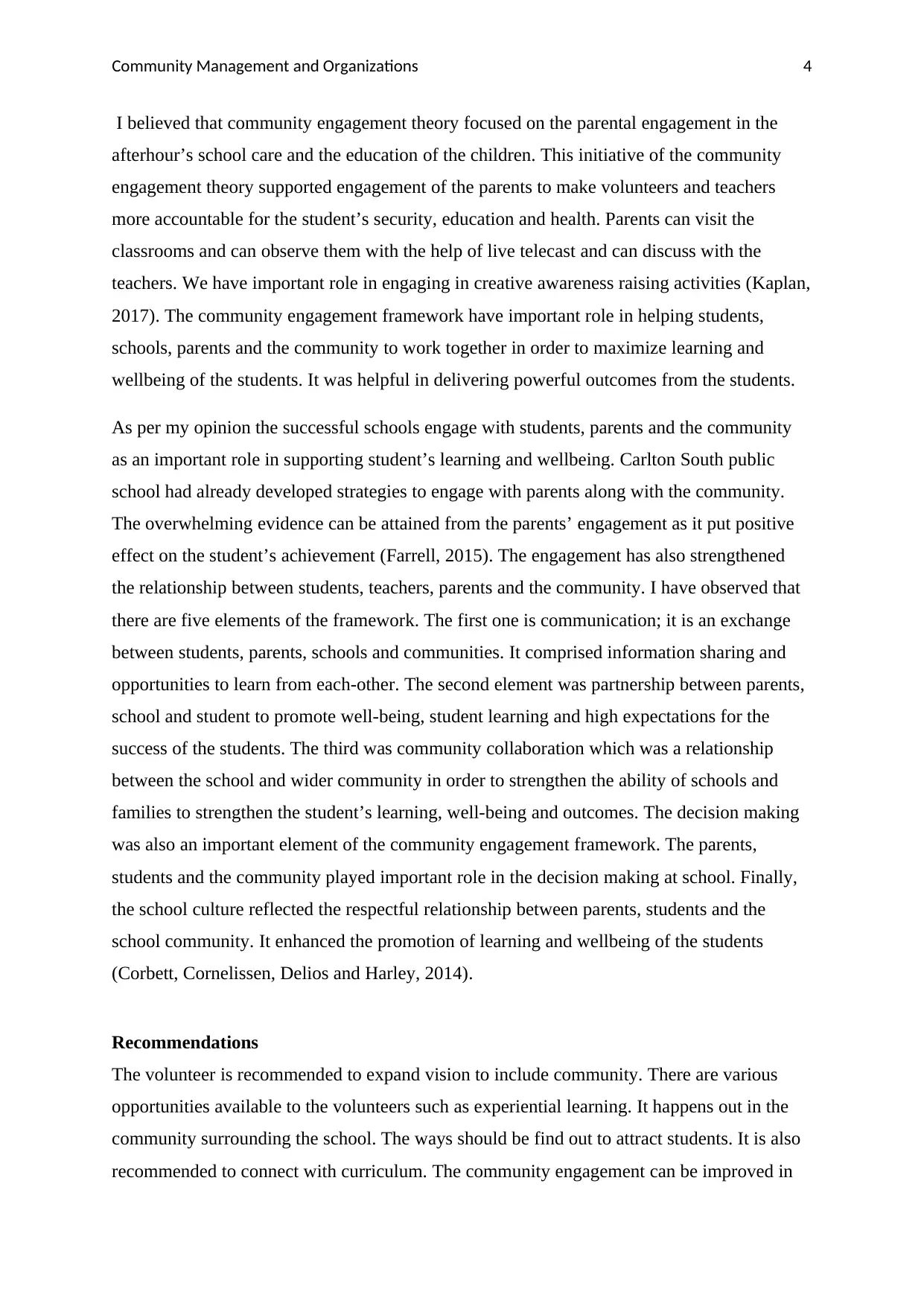
Community Management and Organizations 4
I believed that community engagement theory focused on the parental engagement in the
afterhour’s school care and the education of the children. This initiative of the community
engagement theory supported engagement of the parents to make volunteers and teachers
more accountable for the student’s security, education and health. Parents can visit the
classrooms and can observe them with the help of live telecast and can discuss with the
teachers. We have important role in engaging in creative awareness raising activities (Kaplan,
2017). The community engagement framework have important role in helping students,
schools, parents and the community to work together in order to maximize learning and
wellbeing of the students. It was helpful in delivering powerful outcomes from the students.
As per my opinion the successful schools engage with students, parents and the community
as an important role in supporting student’s learning and wellbeing. Carlton South public
school had already developed strategies to engage with parents along with the community.
The overwhelming evidence can be attained from the parents’ engagement as it put positive
effect on the student’s achievement (Farrell, 2015). The engagement has also strengthened
the relationship between students, teachers, parents and the community. I have observed that
there are five elements of the framework. The first one is communication; it is an exchange
between students, parents, schools and communities. It comprised information sharing and
opportunities to learn from each-other. The second element was partnership between parents,
school and student to promote well-being, student learning and high expectations for the
success of the students. The third was community collaboration which was a relationship
between the school and wider community in order to strengthen the ability of schools and
families to strengthen the student’s learning, well-being and outcomes. The decision making
was also an important element of the community engagement framework. The parents,
students and the community played important role in the decision making at school. Finally,
the school culture reflected the respectful relationship between parents, students and the
school community. It enhanced the promotion of learning and wellbeing of the students
(Corbett, Cornelissen, Delios and Harley, 2014).
Recommendations
The volunteer is recommended to expand vision to include community. There are various
opportunities available to the volunteers such as experiential learning. It happens out in the
community surrounding the school. The ways should be find out to attract students. It is also
recommended to connect with curriculum. The community engagement can be improved in
I believed that community engagement theory focused on the parental engagement in the
afterhour’s school care and the education of the children. This initiative of the community
engagement theory supported engagement of the parents to make volunteers and teachers
more accountable for the student’s security, education and health. Parents can visit the
classrooms and can observe them with the help of live telecast and can discuss with the
teachers. We have important role in engaging in creative awareness raising activities (Kaplan,
2017). The community engagement framework have important role in helping students,
schools, parents and the community to work together in order to maximize learning and
wellbeing of the students. It was helpful in delivering powerful outcomes from the students.
As per my opinion the successful schools engage with students, parents and the community
as an important role in supporting student’s learning and wellbeing. Carlton South public
school had already developed strategies to engage with parents along with the community.
The overwhelming evidence can be attained from the parents’ engagement as it put positive
effect on the student’s achievement (Farrell, 2015). The engagement has also strengthened
the relationship between students, teachers, parents and the community. I have observed that
there are five elements of the framework. The first one is communication; it is an exchange
between students, parents, schools and communities. It comprised information sharing and
opportunities to learn from each-other. The second element was partnership between parents,
school and student to promote well-being, student learning and high expectations for the
success of the students. The third was community collaboration which was a relationship
between the school and wider community in order to strengthen the ability of schools and
families to strengthen the student’s learning, well-being and outcomes. The decision making
was also an important element of the community engagement framework. The parents,
students and the community played important role in the decision making at school. Finally,
the school culture reflected the respectful relationship between parents, students and the
school community. It enhanced the promotion of learning and wellbeing of the students
(Corbett, Cornelissen, Delios and Harley, 2014).
Recommendations
The volunteer is recommended to expand vision to include community. There are various
opportunities available to the volunteers such as experiential learning. It happens out in the
community surrounding the school. The ways should be find out to attract students. It is also
recommended to connect with curriculum. The community engagement can be improved in
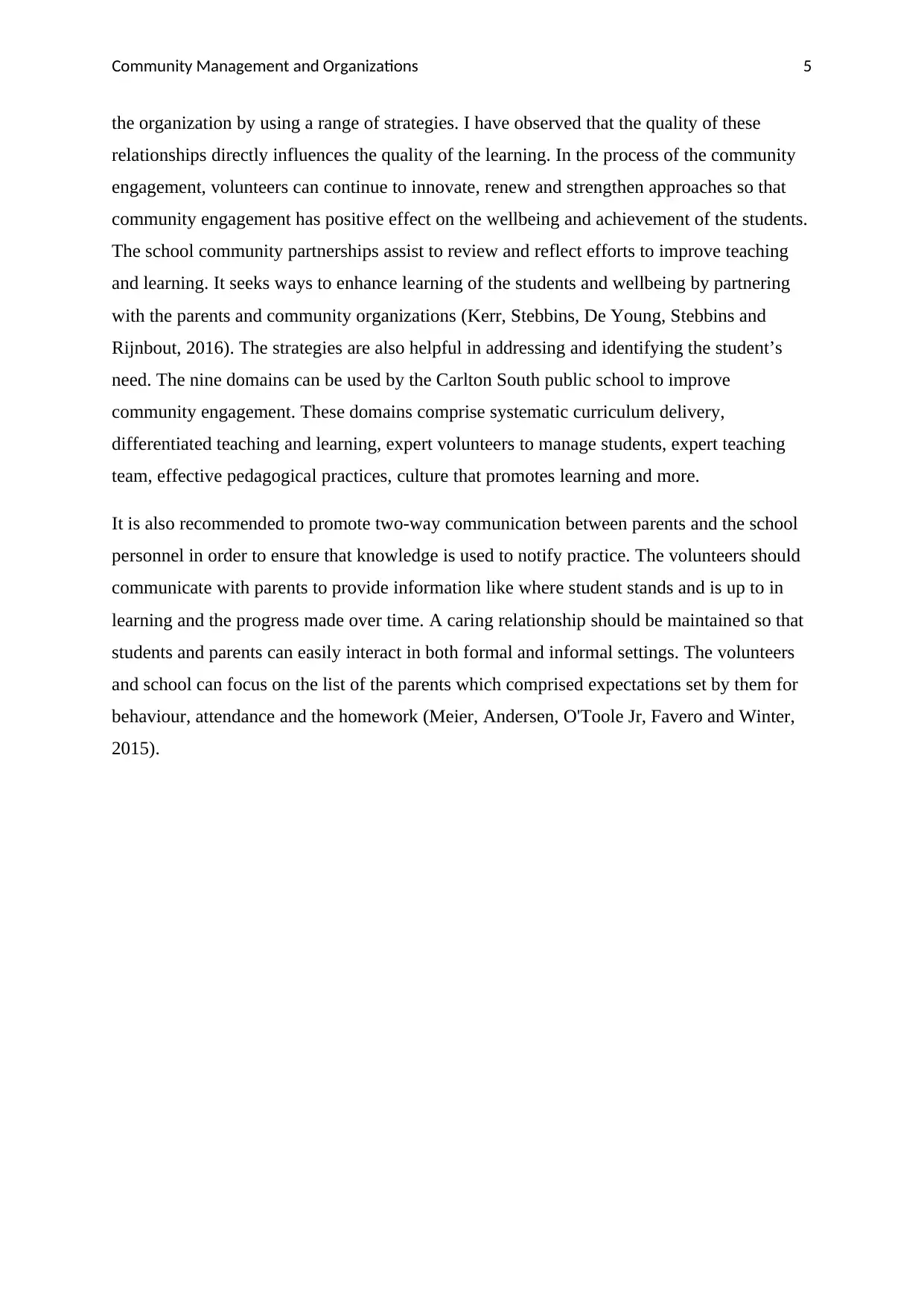
Community Management and Organizations 5
the organization by using a range of strategies. I have observed that the quality of these
relationships directly influences the quality of the learning. In the process of the community
engagement, volunteers can continue to innovate, renew and strengthen approaches so that
community engagement has positive effect on the wellbeing and achievement of the students.
The school community partnerships assist to review and reflect efforts to improve teaching
and learning. It seeks ways to enhance learning of the students and wellbeing by partnering
with the parents and community organizations (Kerr, Stebbins, De Young, Stebbins and
Rijnbout, 2016). The strategies are also helpful in addressing and identifying the student’s
need. The nine domains can be used by the Carlton South public school to improve
community engagement. These domains comprise systematic curriculum delivery,
differentiated teaching and learning, expert volunteers to manage students, expert teaching
team, effective pedagogical practices, culture that promotes learning and more.
It is also recommended to promote two-way communication between parents and the school
personnel in order to ensure that knowledge is used to notify practice. The volunteers should
communicate with parents to provide information like where student stands and is up to in
learning and the progress made over time. A caring relationship should be maintained so that
students and parents can easily interact in both formal and informal settings. The volunteers
and school can focus on the list of the parents which comprised expectations set by them for
behaviour, attendance and the homework (Meier, Andersen, O'Toole Jr, Favero and Winter,
2015).
the organization by using a range of strategies. I have observed that the quality of these
relationships directly influences the quality of the learning. In the process of the community
engagement, volunteers can continue to innovate, renew and strengthen approaches so that
community engagement has positive effect on the wellbeing and achievement of the students.
The school community partnerships assist to review and reflect efforts to improve teaching
and learning. It seeks ways to enhance learning of the students and wellbeing by partnering
with the parents and community organizations (Kerr, Stebbins, De Young, Stebbins and
Rijnbout, 2016). The strategies are also helpful in addressing and identifying the student’s
need. The nine domains can be used by the Carlton South public school to improve
community engagement. These domains comprise systematic curriculum delivery,
differentiated teaching and learning, expert volunteers to manage students, expert teaching
team, effective pedagogical practices, culture that promotes learning and more.
It is also recommended to promote two-way communication between parents and the school
personnel in order to ensure that knowledge is used to notify practice. The volunteers should
communicate with parents to provide information like where student stands and is up to in
learning and the progress made over time. A caring relationship should be maintained so that
students and parents can easily interact in both formal and informal settings. The volunteers
and school can focus on the list of the parents which comprised expectations set by them for
behaviour, attendance and the homework (Meier, Andersen, O'Toole Jr, Favero and Winter,
2015).
⊘ This is a preview!⊘
Do you want full access?
Subscribe today to unlock all pages.

Trusted by 1+ million students worldwide
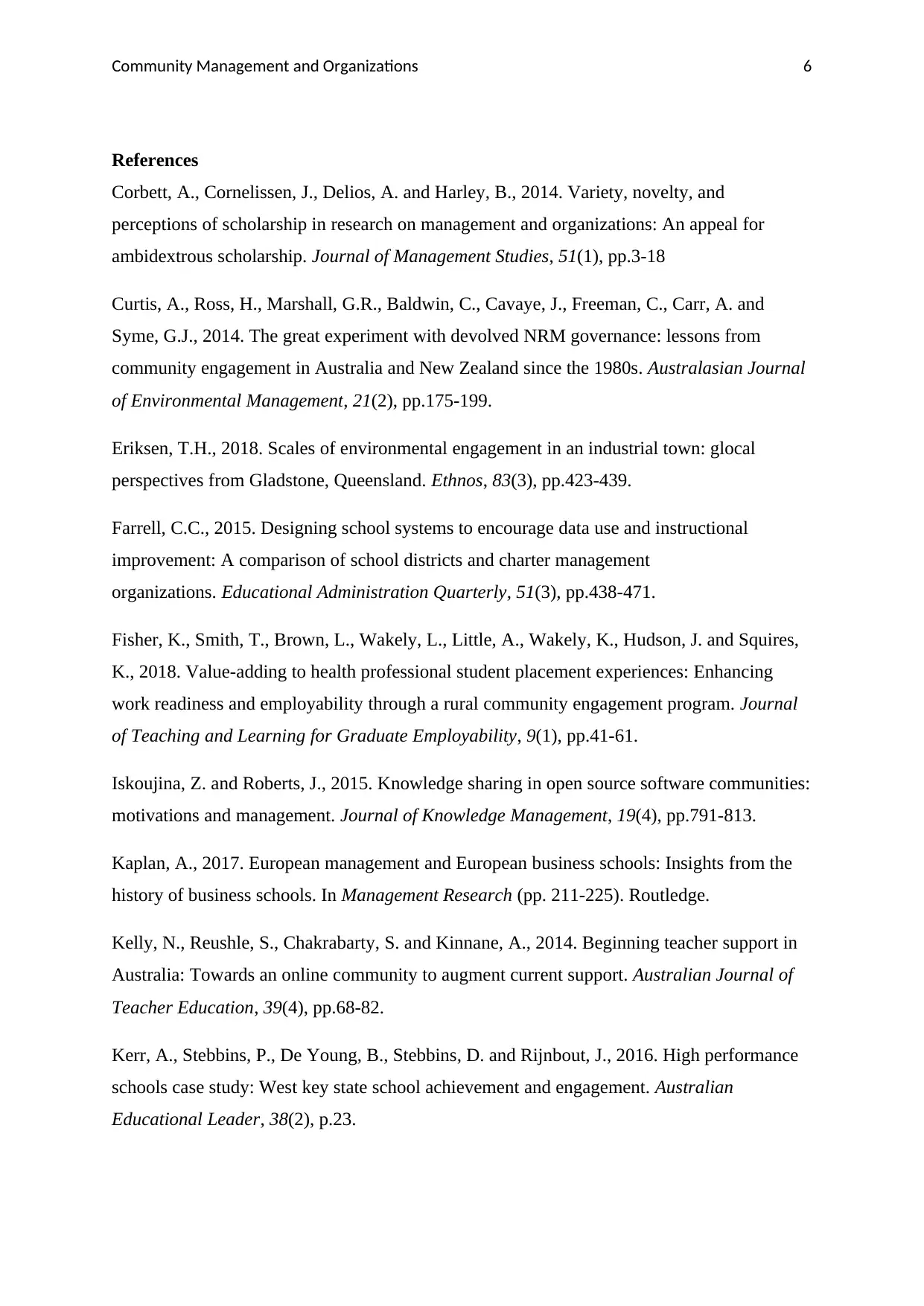
Community Management and Organizations 6
References
Corbett, A., Cornelissen, J., Delios, A. and Harley, B., 2014. Variety, novelty, and
perceptions of scholarship in research on management and organizations: An appeal for
ambidextrous scholarship. Journal of Management Studies, 51(1), pp.3-18
Curtis, A., Ross, H., Marshall, G.R., Baldwin, C., Cavaye, J., Freeman, C., Carr, A. and
Syme, G.J., 2014. The great experiment with devolved NRM governance: lessons from
community engagement in Australia and New Zealand since the 1980s. Australasian Journal
of Environmental Management, 21(2), pp.175-199.
Eriksen, T.H., 2018. Scales of environmental engagement in an industrial town: glocal
perspectives from Gladstone, Queensland. Ethnos, 83(3), pp.423-439.
Farrell, C.C., 2015. Designing school systems to encourage data use and instructional
improvement: A comparison of school districts and charter management
organizations. Educational Administration Quarterly, 51(3), pp.438-471.
Fisher, K., Smith, T., Brown, L., Wakely, L., Little, A., Wakely, K., Hudson, J. and Squires,
K., 2018. Value-adding to health professional student placement experiences: Enhancing
work readiness and employability through a rural community engagement program. Journal
of Teaching and Learning for Graduate Employability, 9(1), pp.41-61.
Iskoujina, Z. and Roberts, J., 2015. Knowledge sharing in open source software communities:
motivations and management. Journal of Knowledge Management, 19(4), pp.791-813.
Kaplan, A., 2017. European management and European business schools: Insights from the
history of business schools. In Management Research (pp. 211-225). Routledge.
Kelly, N., Reushle, S., Chakrabarty, S. and Kinnane, A., 2014. Beginning teacher support in
Australia: Towards an online community to augment current support. Australian Journal of
Teacher Education, 39(4), pp.68-82.
Kerr, A., Stebbins, P., De Young, B., Stebbins, D. and Rijnbout, J., 2016. High performance
schools case study: West key state school achievement and engagement. Australian
Educational Leader, 38(2), p.23.
References
Corbett, A., Cornelissen, J., Delios, A. and Harley, B., 2014. Variety, novelty, and
perceptions of scholarship in research on management and organizations: An appeal for
ambidextrous scholarship. Journal of Management Studies, 51(1), pp.3-18
Curtis, A., Ross, H., Marshall, G.R., Baldwin, C., Cavaye, J., Freeman, C., Carr, A. and
Syme, G.J., 2014. The great experiment with devolved NRM governance: lessons from
community engagement in Australia and New Zealand since the 1980s. Australasian Journal
of Environmental Management, 21(2), pp.175-199.
Eriksen, T.H., 2018. Scales of environmental engagement in an industrial town: glocal
perspectives from Gladstone, Queensland. Ethnos, 83(3), pp.423-439.
Farrell, C.C., 2015. Designing school systems to encourage data use and instructional
improvement: A comparison of school districts and charter management
organizations. Educational Administration Quarterly, 51(3), pp.438-471.
Fisher, K., Smith, T., Brown, L., Wakely, L., Little, A., Wakely, K., Hudson, J. and Squires,
K., 2018. Value-adding to health professional student placement experiences: Enhancing
work readiness and employability through a rural community engagement program. Journal
of Teaching and Learning for Graduate Employability, 9(1), pp.41-61.
Iskoujina, Z. and Roberts, J., 2015. Knowledge sharing in open source software communities:
motivations and management. Journal of Knowledge Management, 19(4), pp.791-813.
Kaplan, A., 2017. European management and European business schools: Insights from the
history of business schools. In Management Research (pp. 211-225). Routledge.
Kelly, N., Reushle, S., Chakrabarty, S. and Kinnane, A., 2014. Beginning teacher support in
Australia: Towards an online community to augment current support. Australian Journal of
Teacher Education, 39(4), pp.68-82.
Kerr, A., Stebbins, P., De Young, B., Stebbins, D. and Rijnbout, J., 2016. High performance
schools case study: West key state school achievement and engagement. Australian
Educational Leader, 38(2), p.23.
Paraphrase This Document
Need a fresh take? Get an instant paraphrase of this document with our AI Paraphraser
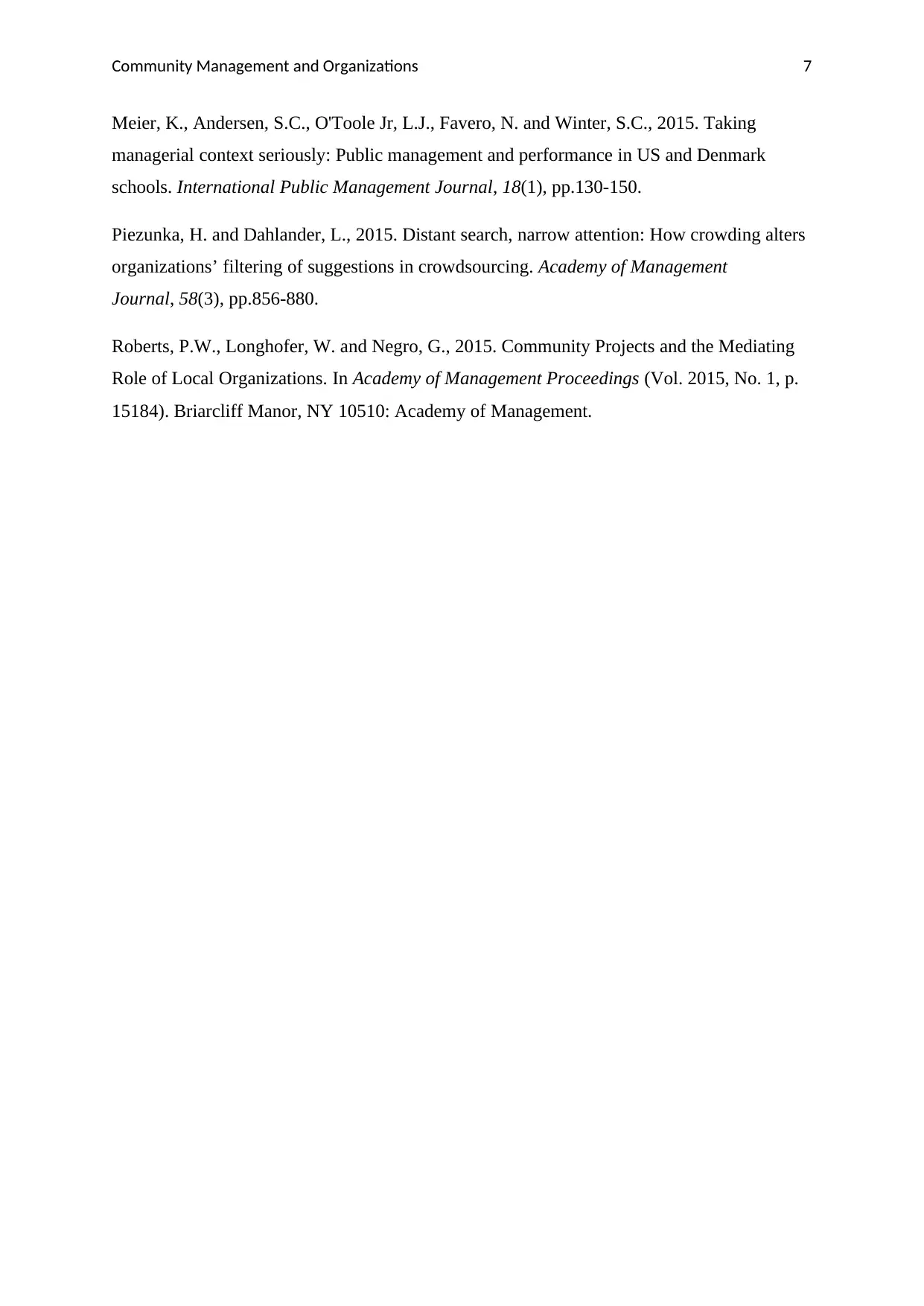
Community Management and Organizations 7
Meier, K., Andersen, S.C., O'Toole Jr, L.J., Favero, N. and Winter, S.C., 2015. Taking
managerial context seriously: Public management and performance in US and Denmark
schools. International Public Management Journal, 18(1), pp.130-150.
Piezunka, H. and Dahlander, L., 2015. Distant search, narrow attention: How crowding alters
organizations’ filtering of suggestions in crowdsourcing. Academy of Management
Journal, 58(3), pp.856-880.
Roberts, P.W., Longhofer, W. and Negro, G., 2015. Community Projects and the Mediating
Role of Local Organizations. In Academy of Management Proceedings (Vol. 2015, No. 1, p.
15184). Briarcliff Manor, NY 10510: Academy of Management.
Meier, K., Andersen, S.C., O'Toole Jr, L.J., Favero, N. and Winter, S.C., 2015. Taking
managerial context seriously: Public management and performance in US and Denmark
schools. International Public Management Journal, 18(1), pp.130-150.
Piezunka, H. and Dahlander, L., 2015. Distant search, narrow attention: How crowding alters
organizations’ filtering of suggestions in crowdsourcing. Academy of Management
Journal, 58(3), pp.856-880.
Roberts, P.W., Longhofer, W. and Negro, G., 2015. Community Projects and the Mediating
Role of Local Organizations. In Academy of Management Proceedings (Vol. 2015, No. 1, p.
15184). Briarcliff Manor, NY 10510: Academy of Management.
1 out of 8
Related Documents
Your All-in-One AI-Powered Toolkit for Academic Success.
+13062052269
info@desklib.com
Available 24*7 on WhatsApp / Email
![[object Object]](/_next/static/media/star-bottom.7253800d.svg)
Unlock your academic potential
Copyright © 2020–2025 A2Z Services. All Rights Reserved. Developed and managed by ZUCOL.





